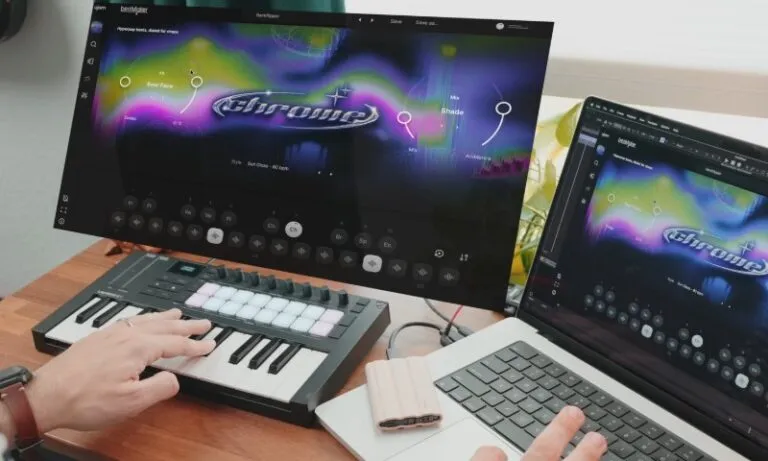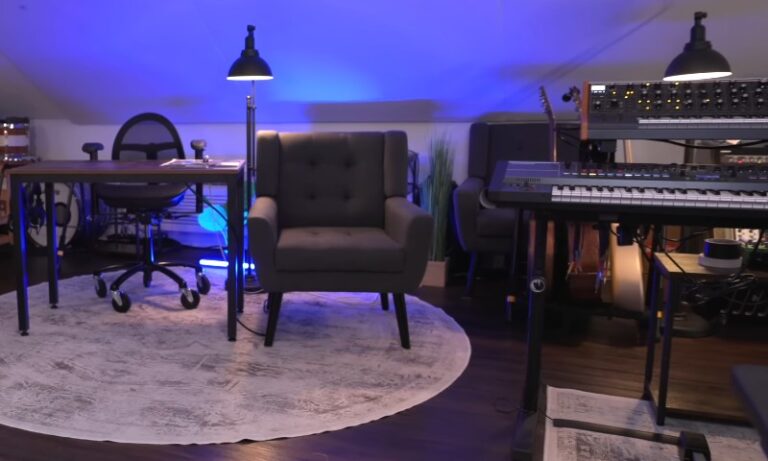Finger strength on guitar isn’t about crushing the fretboard or turning your hand into a claw. It’s about creating the kind of force, control, and timing that lets you play longer, cleaner, and faster, without hurting yourself.
You don’t need a gym membership for your hands. You need smart, bite-sized drills, a sensible practice plan, and a little science to keep you fast, in time, and injury-free.
Here’s a guide drawn from performing-arts medicine, motor-learning research, and reputable music education sources. Let’s get started.
Table of Contents
ToggleKey Points
- Finger strength for guitar is about coordination, endurance, and timing, not just force.
- Warm up your whole body first, then do tendon-gliding and light playing to prevent injuries.
- Rotate focused drills like chromatic ladders, trills, spiders, and accent grids to build control and speed.
- Use a metronome, progress gradually, and take breaks to avoid overuse and improve consistency.
What “Finger Strength” Really Means for Guitarists

Most players say “strength” when they actually mean a mix of five things: force, endurance, independence, control, speed, and timing.
Research on trained keyboardists shows that top performers don’t have special hand anatomy. Their edge comes from neuromuscular control and finger individuation built through targeted practice.
The takeaway is simple: build force, yes, but focus even more on independence and clean timing. A strong hand that moves as one unit won’t help alternate picking or legato if it lacks coordination.
Warm Up the Musician, Not Just the Fingers
Good warm-ups raise blood flow and prep joints and tendons before the serious work. Performing-arts medicine groups recommend short, whole-body warm-ups away from the instrument, then moving into instrument-specific motions.
A Quick Warm-Up Recipe
- 3–5 minutes of light movement: marching in place, shoulder circles, side bends, gentle wrist circles.
- 2–3 minutes of easy open-string picking and slow fretted notes.
Why not start with static stretches? Because acute, long static stretches can temporarily reduce immediate strength or power. Use dynamic movement to warm up first, then save longer static holds for cool-downs or separate flexibility work.
Keep Tendons Sliding and Wrists Happy
Daily tendon-gliding sequences help the flexor and extensor tendons move smoothly in their sheaths.
Hand therapy services in the UK recommend series like straight–hook–full fist and straight–table–straight, performed with a neutral wrist. These moves are prescribed after injury but are equally useful for prevention.
Micro-Routine (2 minutes)
- Fingers straight
- “Hook” fist
- Full fist
- Table-top
- Straight again
Hold each position for a comfortable moment, keep the wrist neutral, and breathe. If you feel tingling, pain, or catching, stop and consult a clinician familiar with musicians.
Evidence-Based Practice Planning for Speed and Accuracy
Motor-learning research gives us two big levers: tempo structure and practice variability.
- Tempo structure: Piano studies show finger individuation gets harder as tempo rises. Link speed building to gradual tempo steps with strict relaxation and evenness checks.
- Practice variability: Varying drills and contexts aids consolidation and transfer, though the effect depends on task type and variability amount. Blend blocked reps with interleaved patterns for musical skills.
Metronome use is not optional. Berklee instructors repeatedly recommend scale work and drills with a metronome for timing, consistency, and listening discipline.
A guitar teacher near me can also help you master metronome work and structure your practice routine.
Start slower than you think and only step up when tone and timing are solid.
Six Proven Exercises You Can Rotate Weekly
The goal here is to build functional force and timing, not turn your forearm into a powerlifting tool.
1. Chromatic Ladders
What it trains: fingertip pressure, left-hand independence, clean shifts, and right-hand synchronization.
How
- Set a click at a comfortable tempo.
- On one string, play 1-2-3-4 up the frets, then 4-3-2-1 down.
- Repeat on each string.
- Use rest strokes for classical, alternate pick for electric or steel-string.
- Step the metronome up by 2 to 4 bpm only when every note is even.
Coaching Cues
- Keep thumb light behind the neck.
- Drop fingers from near the fret to reduce wasted effort.
- Release pressure between notes, no white-knuckle grip.
2. Trills That Build Strength Without Death-Gripping
What it trains: local force and endurance at realistic ranges of motion.
How
- Pick the 5th fret with index, hammer the 6th with middle, then pull off back to 5.
- Do 20 to 30 seconds per finger pair: 1-2, 1-3, 1-4, 2-3, 2-4, 3-4.
- Keep wrist neutral and knuckles high.
Research on pianists and finger plyometrics shows repeated rapid finger movements can improve strength, precision, and efficiency when done progressively.
3. “Spider” Independence Patterns

What it trains: lateral control and independence between nonadjacent fingers.
How
- On two adjacent strings, play 1 on string A, 3 on string B, 2 on string A, 4 on string B, then invert.
- Move up a fret each cycle.
- Keep fingers close to the board to limit wasted motion.
Piano research shows expert dexterity stems from neuromuscular control rather than unique anatomy, making drills that isolate independence especially valuable.
4. Accent Grids for Right- and Left-Hand Synchronization
What it trains: timing accuracy under speed.
How
- Take any four-note pattern and shift the accent every note: Accent 1, then accent 2, then accent 3, then accent 4.
- Do the same with triplets and sextuplets.
- Small, structured variability helps long-term consolidation and transfer when not overdone.
5. Position-Shift “Ramps”
What it trains: smooth pressure changes and relaxed shifts.
How
- Choose a four-note cell, then move it up the neck every bar without pausing.
- Keep left thumb light and time the shift with the right-hand stroke so the note before the move stays full length.
- Musicians who measure dynamic finger forces learn to avoid squeezing during shifts for better tone and endurance.
6. Pick-Hand Burst Sets
What it trains: speed without tension.
How
- On a single open string, do 1 second of very fast alternate picking, then 3 seconds easy.
- Repeat 6 to 8 rounds.
- You’re teaching your nervous system to visit high speed briefly without locking up.
- Blend with metronome work from slow to medium tempos for endurance.
Strength Training That Actually Helps Guitar

A classic question: does general strength work improve instrument performance? Finger-specific strength training can change interaction between fingers and improve performance.
Plyometric finger work also shows improvements in precision and efficiency for fast movements. Keep loads sensible and joint angles guitar-realistic.
Smart Options
- Isometric squeezes at the fretboard rather than maximal grippers in the air. Press down a held chord with steady, moderate force for 10 to 20 seconds, relax, repeat.
- Rubber-band finger extensions for balance, 2 to 3 sets of 15 to 20 slow reps.
- Forearm endurance with light wrist curls and reverse curls for 2 sets of 12 to 15, focusing on smooth control.
Large, repeated maximal gripper work does not teach finger independence or timing and can irritate tendons if you already practice a lot. If you add it, do it slowly and monitor how your hands feel on the guitar.
How to Organize a Week That Makes You Faster

Blend blocked and interleaved practice with progressive tempos. Motor-learning studies suggest variability helps consolidation, but too much chaos can stall early learning. Split sessions to get both.
Sample 7-Day Microcycle
| Segment | Time | Focus |
| Daily Warm-Up | 5 min | Whole-body movement + tendon glides |
| Block A: Mechanics | 15 min | Chromatic ladders at 60–80 bpm; trills by finger pair |
| Block B: Synchronization | 10 min | Accent grids and/or spiders |
| Block C: Repertoire Application | 15 min | Apply same accents and tempo steps to your licks or etudes |
| Cool-Down | 2 min | Easy open strings, slow long notes, optional static stretch after |
The 10-Minute Metronome Ladder for Speed
Pick one pattern, one string, one position.
- Two minutes: play straight 8ths, perfect tone.
- Two minutes: accent every fourth note.
- Two minutes: accent every third note.
- Two minutes: short burst sets on the open string.
- Two minutes: return to the pattern and step the tempo up by 2 bpm only if the click still feels invisible in your hands.
Metronome-anchored scale work is standard in top music programs because it develops timing and consistency.
Common Pitfalls and Quick Fixes
- Over-gripping: relax the thumb and release pressure between notes. If your fingertip color changes or the nail bed blanches, you’re pressing too hard.
- Flying fingers: practice the chromatic ladder with a rule that inactive fingers hover 1–2 mm above the string.
- Going faster to get faster: research on individuation and tempo says the opposite. Keep the speed where control is perfect and creep upward slowly.
- Skipping warm-ups and breaks: linked with higher injury risk in musicians.
Protect Your Hands Like the Career Tools They Are
Musicians are athletes of small muscles. Performing-arts medicine resources emphasize healthy practice, early attention to pain, and individual differences like joint hypermobility that may need tailored strengthening and setup changes.
Red Flags to Get Checked Out
- Persistent tingling, numbness, or night pain.
- Sharp pain on a specific motion that does not ease with rest.
- Trouble controlling one finger that used to feel normal.
During injury or flare-ups, mental practice can maintain performance without stressing tissues. It’s an established strategy in performing-arts care.
Example 4-Week Progression You Can Copy
| Week | Focus | Key Additions |
| 1 | Technique base | Chromatic ladders 10 min, trills 90 sec per finger pair, accent grids on one four-note cell |
| 2 | Add independence | Keep Week 1, plus spiders 5 min, start position-shift ramps at slow tempo |
| 3 | Add speed stimulus | Keep Weeks 1–2, add pick-hand burst sets, two days slightly higher metronome ladders, one day dialed back for tone |
| 4 | Consolidate and test | Use interleaving: cycle ladders, trills, spiders in short sets, record yourself start and end of week at same tempo |
If tone degrades at a new top tempo, drop 5 to 8 bpm and rebuild. This gives enough blocked time to lay bricks and enough variability to cement learning, exactly what research suggests about variability and consolidation.
FAQs
Final Quick-Start Checklist
- Warm up your whole body for 3–5 minutes, then do tendon glides.
- Spend 10 minutes on a metronome ladder with one pattern.
- Rotate chromatic ladders, trills, spiders, accent grids, and position-shift ramps.
- Keep the wrist neutral and the thumb light; release pressure between notes.
- Use brief bursts for speed, but build most of your time at tempos where your tone is perfect.
- Take short breaks. If you feel pain or tingling, stop and seek a clinician who understands musicians.
Stick to that playbook for a month and you’ll feel stronger, cleaner, and quicker, with fewer mystery aches and far better control.
Related Posts:
- 10 Best Sweep Picking Exercises - Guitar Tips & Tricks!
- Top Tips to Avoid Guitar String Buzz and Improve Tone
- How to Build Your Unique Rap Style and Swag - A…
- 8 Simple Punk Chord Progressions for Beginners
- How to Build a Personal Brand as a Music Producer…
- 9 Ways to Improve Your Home Studio Without Spending Too Much












